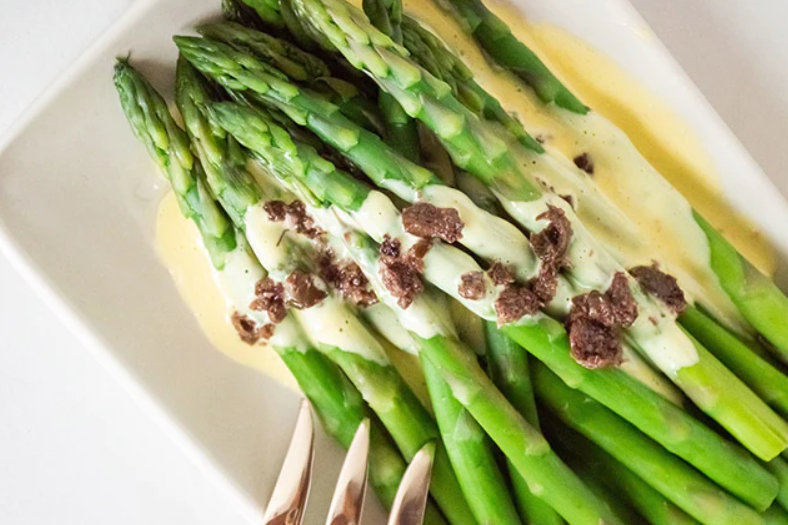
Asparagus - one of the culinary delights of Spring. It's bright green color and flavor bring us fully into the season. The folk name for asparagus is Sparrow Grass. There must have been some name morphing there, but it is charming.
The most common color for asparagus is the bright green one but there is also an Italian purple variety that is sweeter in flavor. White asparagus is cultivated by "blanching" the emerging shoots by covering them with soil so they do not photosynthesize and do not turn green.
The age of the producing plant determines stem thickness. Older plants produce thicker stems of asparagus. While there are fans of both thick and thin stems, cooking and using them is similar. Older, thicker stems may need to be peeled at the end and very thin ones need to be cooked very briefly. Otherwise, flavor does not vary a great deal. Eating asparagus as close to harvest as possible does have an impact on flavor. Finding a source at your local farmers market where the spears will have been harvested very recently, perhaps the morning you buy them - is going to be your premier experience.
When purchasing, you can check the cut end of the stem to determine freshness. The end should be moist and green. Standing them upright in a little water, covered with a plastic bag in your refrigerator is a good way to store them.
Hollandaise is one of the five "Mother" sauces in classic French Cuisine. It is well known as the key ingredient in Eggs Benedict but is also classic served as a sauce for steamed or blanched fresh asparagus. The original is, of course, a butter sauce and delicious as such. This version is adapted to use olive oil for a heart-healthy and delicious alternative.
Enjoying these first offerings of Spring asparagus with an olive oil version of Hollandaise is a perfect choice. You will experience all the flavor and decadence of the butter version but you will feel lighter as you move into Spring! The little sprinkle of McEvoy Ranch Black Olive Tapenade provides a spark of salt and umami that pleases the eye and taste buds as well. If you are feeling really indulgent, sprinkle on a little black caviar!
INSTRUCTIONS
Heat oil over low heat to approximately 120 F.
Combine yolks, 3 Tbs. warm water, lemon juice, salt and cayenne in a blender. Pulse ingredients to combine.
Pour heated oil into a vessel with a pour spout. With blender running, slowly add oil in a thin stream. Thin with reserved water if necessary.
Taste and adjust salt and cayenne if necessary.
Garnish with black olive tapenade.
Certified Organic
By CCOF
Sustainably Produced
At Our Ranch
Early Harvested
High Polyphenols
Award Winning
Extra Virgin Olive Oil




